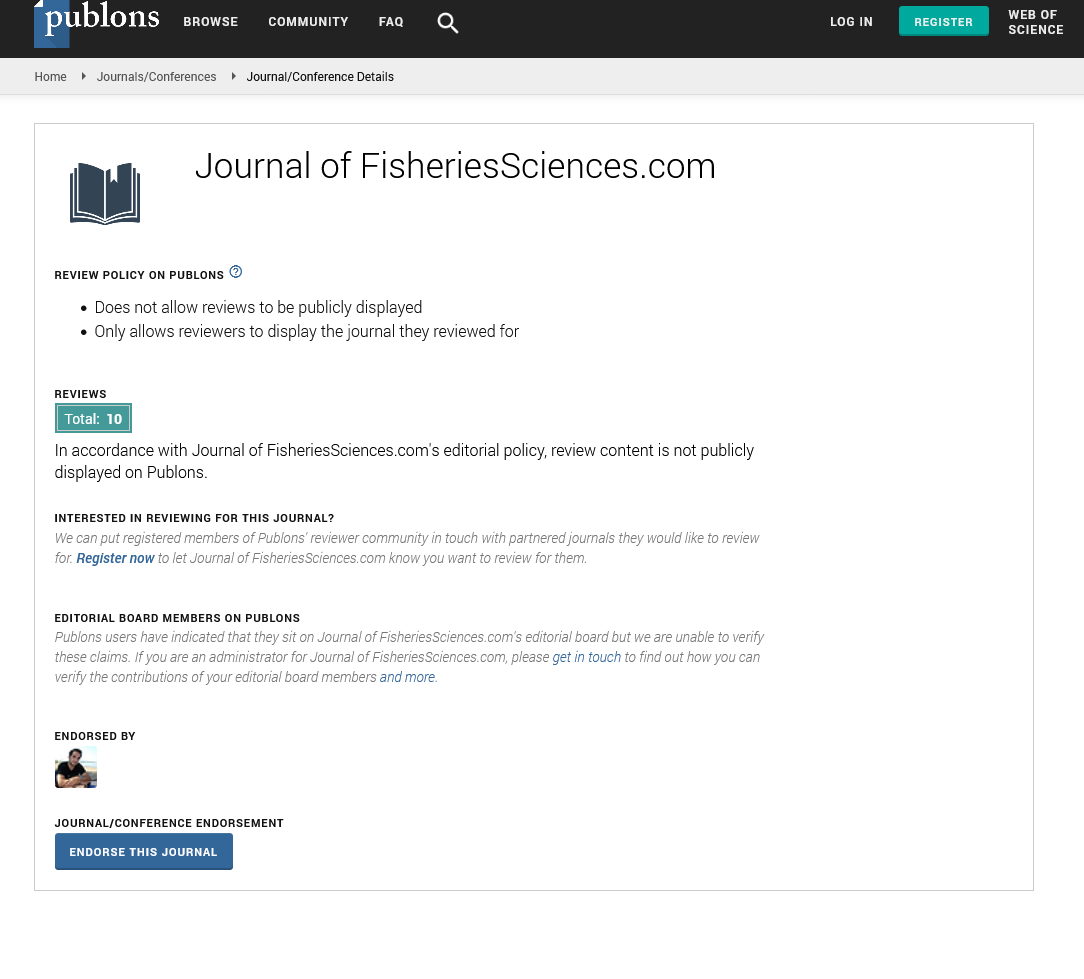Perspective - (2024) Volume 18, Issue 6
Fish Biology: A Comprehensive Overview
Anna Akenova*
Department of Biology and Ecology of Fishes, University of AquaSciences, Ghent, Belgium
*Correspondence:
Anna Akenova, Department of Biology and Ecology of Fishes, University of AquaSciences, Ghent,
Belgium,
Email:
Received: 03-Dec-2024, Manuscript No. IPFS-24-15409;
Editor assigned: 06-Dec-2024, Pre QC No. IPFS-24-15409 (PQ);
Reviewed: 20-Dec-2024, QC No. IPFS-24-15409;
Revised: 23-Dec-2024, Manuscript No. IPFS-24-15409 (R);
Published:
31-Dec-2024
Introduction
Fish are an incredibly diverse group of organisms that have
adapted to nearly every aquatic environment on earth. They play
vital roles in aquatic ecosystems, contribute significantly to
human economies and are subjects of scientific study in many
disciplines. This article delves into the fundamental aspects of
fish biology, exploring their anatomy, physiology, behavior and
ecological significance.
Description
Anatomy and physiology
Fish are characterized by a set of unique anatomical features.
They possess a streamlined body shape, which reduces
resistance and allows for efficient movement through water. This
body shape is complemented by the presence of fins-dorsal,
pectoral, pelvic, anal and caudal-which provide stability,
propulsion and maneuverability.
The skin of fish is covered with scales that vary in size, shape
and texture among different species. These scales provide
protection and reduce drag as the fish swims. Underneath the
scales lies the fish's epidermis, which secretes mucus to further
reduce friction and protect against pathogens.
Fish have a specialized respiratory system that relies on gills
for extracting oxygen from water. Water flows over the gill
membranes, where oxygen diffuses into the bloodstream and
carbon dioxide is expelled. This process is highly efficient and
crucial for the fish's survival in aquatic environments.
The circulatory system of fish is designed to support their
aquatic lifestyle. Most fish have a two-chambered heart that
pumps blood through a single circuit: From the heart to the gills,
where it is oxygenated and then to the rest of the body. This
system is less complex than that of mammals, which have a fourchambered
heart and a double circulatory system.
Sensory systems
Fish possess highly developed sensory systems that help them
navigate their environments and locate food. Their vision is
adapted to different light conditions in aquatic environments,
with some species having specialized eyes that allow them to
see in low light or detect ultraviolet light.
The lateral line system is a unique feature of fish that detects
water movement and pressure changes. This system consists of a
series of sensory organs located along the sides of the fish's
body. It helps fish sense nearby objects and predators, aiding in
navigation and hunting.
Fish also have a well-developed sense of smell, which is
crucial for locating food and detecting pheromones. Their
olfactory organs are located in the nasal cavities and are highly
sensitive to various chemicals in the water.
Reproduction and development
Fish exhibit a wide range of reproductive strategies, from
laying eggs to live birth. The majority of fish reproduce through
external fertilization, where eggs and sperm are released into
the water and fertilization occurs outside the body. In contrast,
some species, such as sharks and rays, employ internal
fertilization, with the embryos developing inside the female's
body.
Eggs are often laid in large numbers to increase the chances
of offspring survival. Fish eggs can be found in various
environments, from open water to hidden nests. The
developmental stages of fish can vary greatly, with some species
undergoing significant metamorphosis from larvae to adults,
while others develop directly into juvenile forms.
Parental care is another aspect of fish reproduction. While
many fish rely on large numbers of eggs to ensure some
offspring survive, others provide care for their young. For
example, some species of fish guard their eggs and protect them
from predators until they hatch.
Behavior and ecology
Fish behavior is influenced by various factors, including
environmental conditions, social interactions and reproductive
needs. Many fish are social animals that form schools or shoals
for protection and foraging. Schooling behavior is particularly
common among small fish species and provides safety in
numbers.
Predation and competition are significant ecological
interactions involving fish. Many fish are predators themselves,
preying on smaller fish, invertebrates and other aquatic
organisms. Conversely, fish are also preyed upon by larger
predators, including birds, mammals and other fish.
Conservation and human impact
Human activities have significant impacts on fish populations
and aquatic ecosystems. Overfishing, habitat destruction,
pollution and climate change are major threats to fish and their
environments. Sustainable management practices and
conservation efforts are essential for maintaining healthy fish
populations and aquatic ecosystems.
Efforts to mitigate the impact of human activities include
establishing marine protected areas, implementing fishing
regulations and restoring damaged habitats. Research and
monitoring are also critical for understanding fish populations
and ensuring their long-term sustainability.
Conclusion
In conclusion, fish biology is a complex and fascinating field
that encompasses various aspects of anatomy, physiology,
behavior and ecology. Understanding these aspects helps us
appreciate the diversity of fish species and the crucial roles they
play in aquatic environments. Continued research and
conservation efforts are vital for preserving fish populations and
ensuring the health of our planet's aquatic ecosystems.
Citation: Akenova A (2024) Fish Biology: A Comprehensive Overview. J Fish Sci. Vol.18 No.6






